THE EVOLUTION OF THE WOODEN BRIDGE
The earliest wooden bridges were built by laying logs across a small stream and nailing boards across them.
These early wooden bridges were constructed by private individuals or small communities to serve a specific purpose or need. Their traffic was mostly people on foot; on horseback or by wagons pulled by horse or oxen.
As roads were cut between the villages and towns, the problem of crossing large rivers was solved with the use of ‘ferries’. But winter, followed by spring thaws caused havoc during crossings.
Solution: build longer bridges.
The essential element in building a longer bridge became a triangular structure known as a truss. The earliest were simple trusses adapted to bridge use but similar to those use in constructing a roof on a building
The King Truss
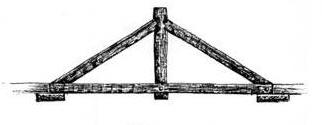
The simplest truss used in constructing a bridge was a King Post Truss.
Wikipedia describes a King Post as: “… a central vertical post used in architectural or bridge designs, working in tension to support a beam below from a truss apex above…”
The Queen Truss
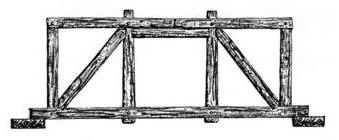
For wider brooks or small rivers a triangle brace was added to each end of a rectangle forming the Queen Post Truss.
From Wikipedia we learn that “A queen post is a tension member in a truss that can span longer openings than a king post truss. A king post uses one central supporting post, whereas the queen post truss uses two. Even though it is a tension member, rather than a compression member, they are commonly still called a post.”
TRUSSES USED IN NEW BRUNSWICK
Remember that a triangular structure has the capacity to withstand a considerable amount of pressure by evenly distributing weight to the three angles. And, by adding a series of triangles to a rectangle they will increase its rigidity and strength. Knowing this we can build a bridge to span wider rivers.
Early bridge builders tried different combinations of triangles and rectangles to form bridge trusses. From these different styles, three types of trusses were used in New Brunswick.
The Howe Truss

Most of the covered bridges in New Brunswick were constructed using the “Howe Truss” design. A design patented by William Howe of Massachusetts.
The superstructure is based on the multiple kingpost design but with heavy metal rods substituted for the vertical timbers. In New Brunswick a second diagonal timber is added to the original single diagonal of the multiple kingpost and positioned in the opposite direction between the vertical rods.
The steel rods were threaded at the end with nuts for tightening or loosening the tension in order to adjust any sagging of the bridge.
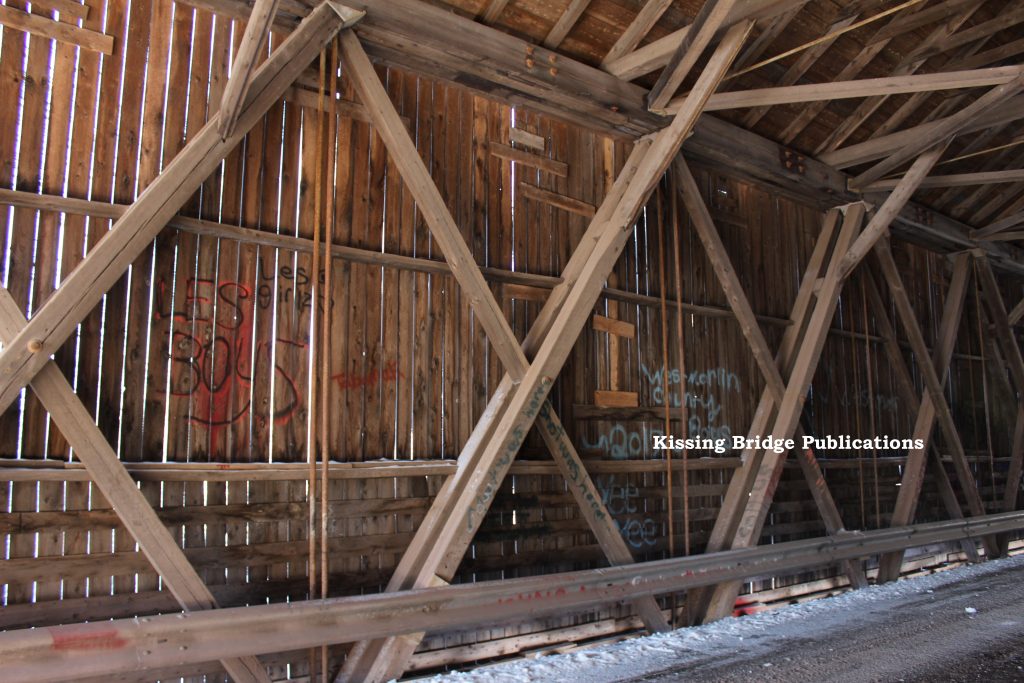
The Multiple King Post Truss

The Multiple Kingpost design consists of one kingpost in the center with several right angle panels on each side of the center.
A few of our provincial covered bridges were built using this design.
The Flume Ridge Bridge in Charlotte County and the Colpitts Bridge in Albert County are examples of this type of construction.
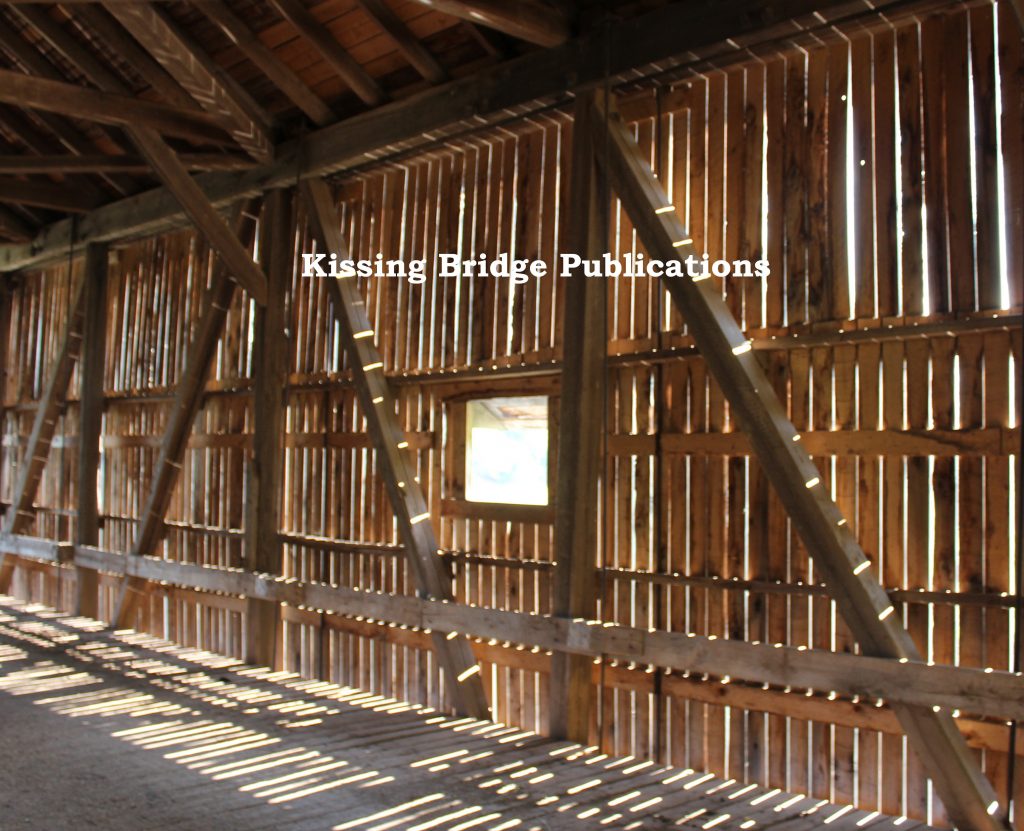
The Town Truss
The “Town Truss”, engineered by Ithiel Town of America, was shaped like a lattice. The timbers were pegged together and, as vehicles crossed the bridge their weight would automatically tighten the framework.
The Nelson Hollow Bridge in Doaktown, is constructed using a variation of the Town Truss.
WHY COVER A WOODEN BRIDGE?
Building bridges using wood became the preferred method of spanning a stream where timber was abundant, cheap and close at hand. But left unprotected they were subject to rot from rain and melting snow.
Then someone had a better idea. Buildings constructed of wood, such as homes, were not as susceptible to weather rot. Why not cover the timber bridges and protect them from the elements? With proper maintenance a covered bridge would last indefinitely. For example: The Nelson Hollow Bridge in Doaktown was built in 1900.
Covering a timber bridge is a fairly easy thing to do. Roof rafters are built between the bridges framework, board in the rafters and add roofing to complete the cover. Then it is just a matter of nailing boards to the framed sides.
COMMON FEATURES OF A COVERED BRIDGE
Siding
If you were to visit a covered bridge today, you would probably notice different length boards covering the sides of the bridge. Originally the boards were long enough to reach from the eave to the base. As the siding weathered, the boards would rot near the bottom. It became economical to replace the siding by cutting off the damaged portion and replacing that portion with a new board. This accounts for the two levels of boards on the bridge wall.
The accompanying photo shows the two levels of siding.
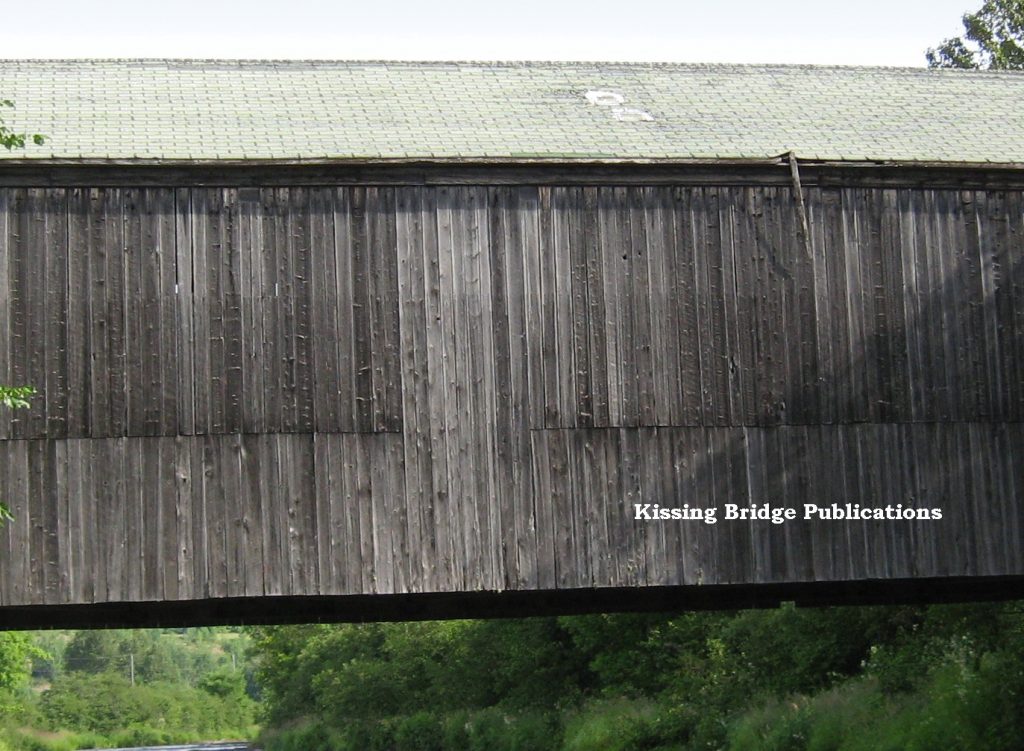
Paint
In many parts of North America covered bridges are painted.
In New Brunswick the only covered bridge sporting a coat of paint is the Point Wolfe Covered Bridge in Fundy National Park.
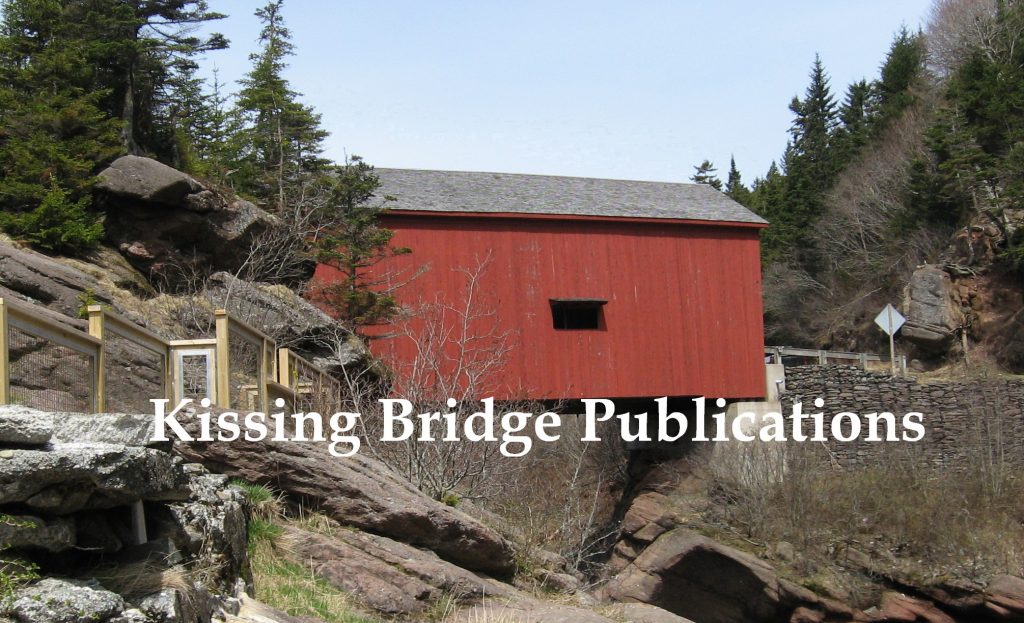
The Roof
All but two of the remaining covered bridges in New Brunswick were constructed with an A-line roof. An A-line roof is built the same way as many house – a peak, high at the center and sloping down each side to repel rain.
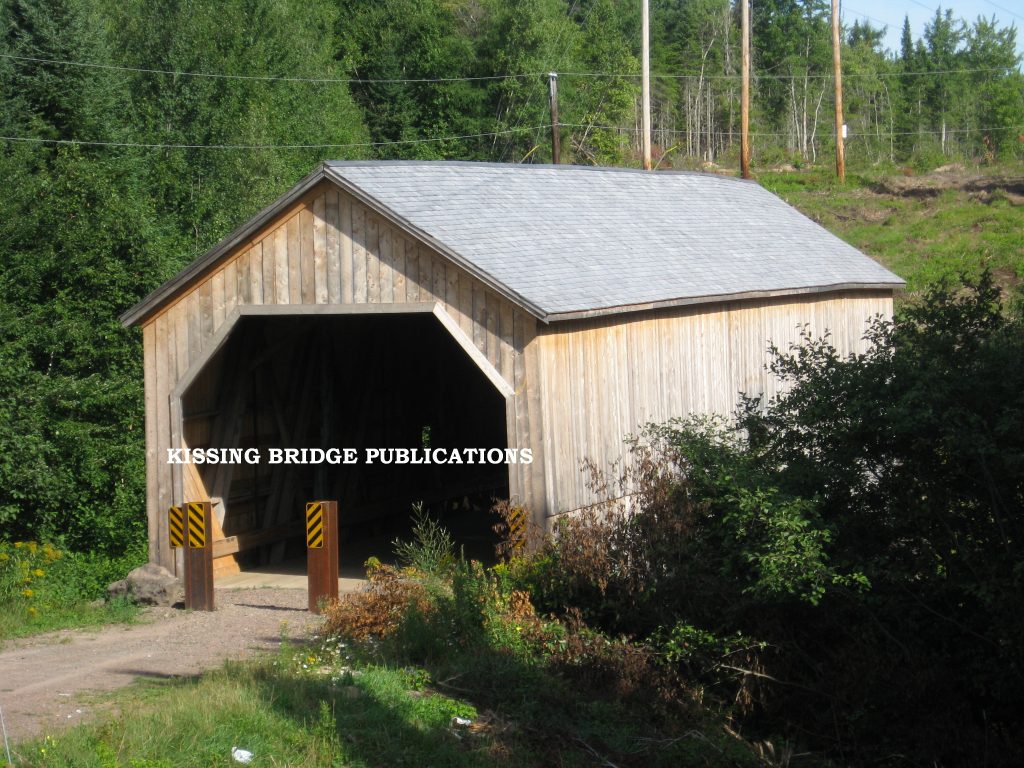
The Mansard or ‘hip’ roof has a slope on each end as well as down each side. Examples of this can be found on the Peter Jonah Bridge in Albert County and on the Nelson Hollow Bridge in Doaktown.
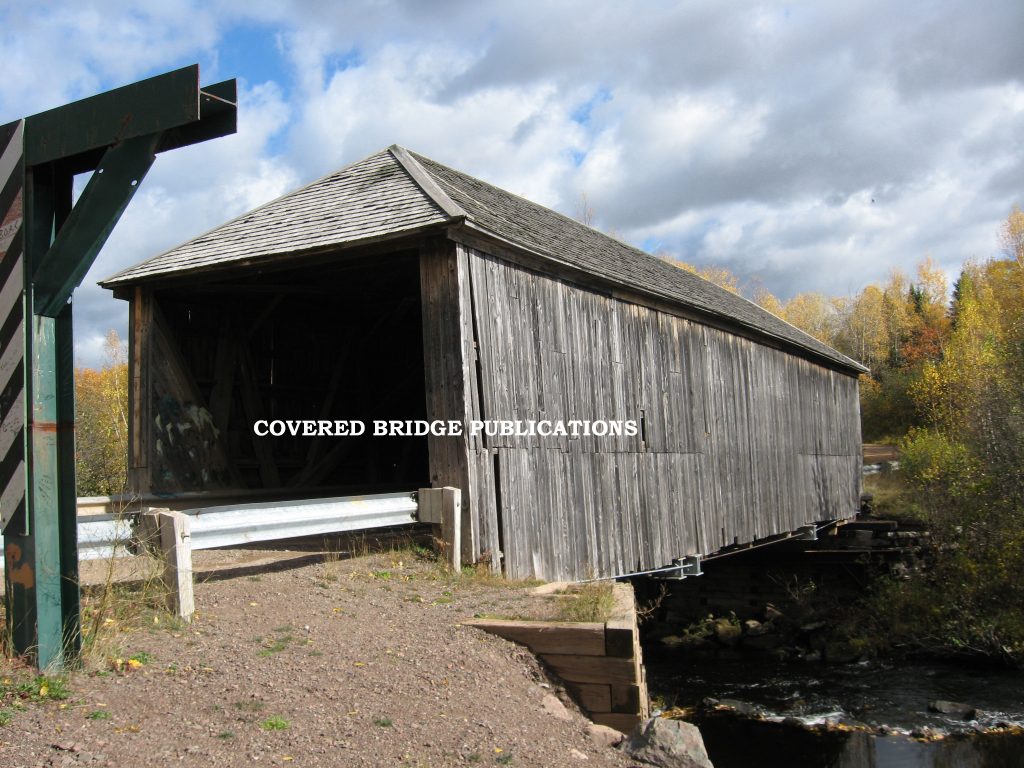
The original roofing material on most covered bridges were boards covered by cedar shakes. Some have metal roofs similar to those found on barns while others are roofed using the three-in-one asphalt shingles found on most homes.
Portals
The entrance to a covered bridge is called a ‘portal’. Three styles of portals will be found on our provincial covered bridges. Square, round and with triangular corners.

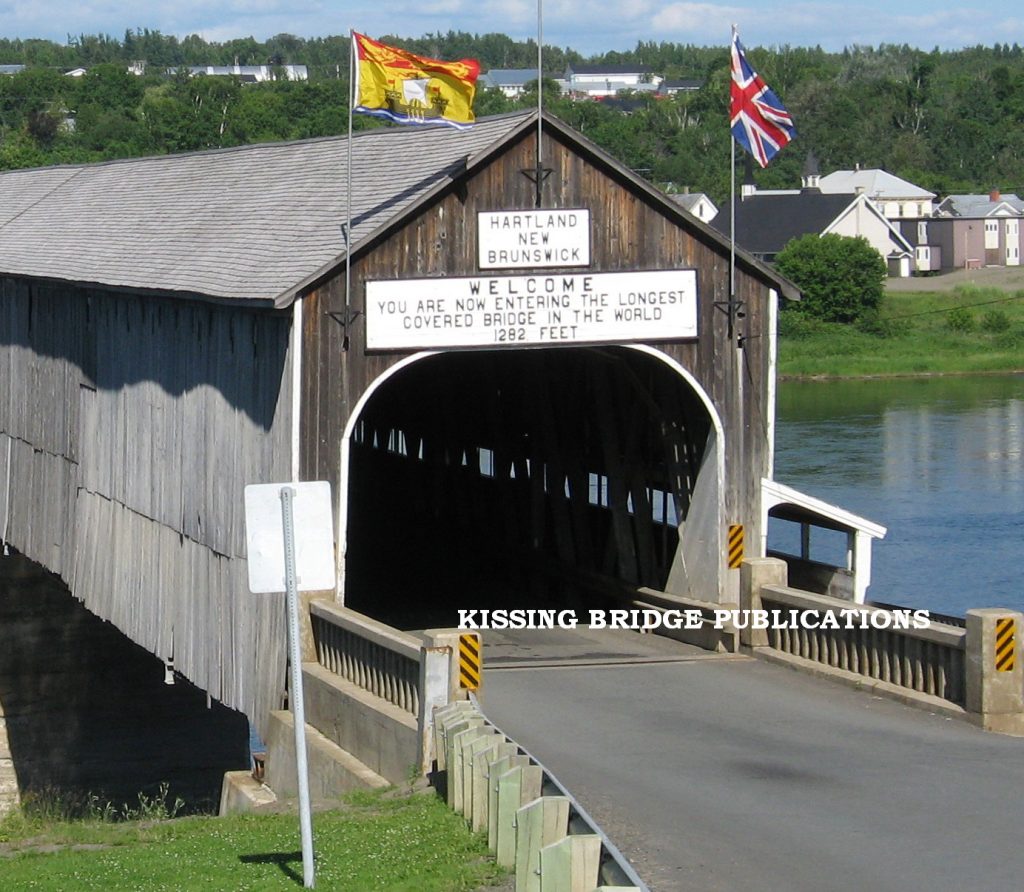

Windows
A few of New Brunswick’s longer covered bridges have windows to let in light. Some bridges have a window on the end to let a person using the bridge to see if anything is approaching from the other side. Awnings were added to keep out the weather.
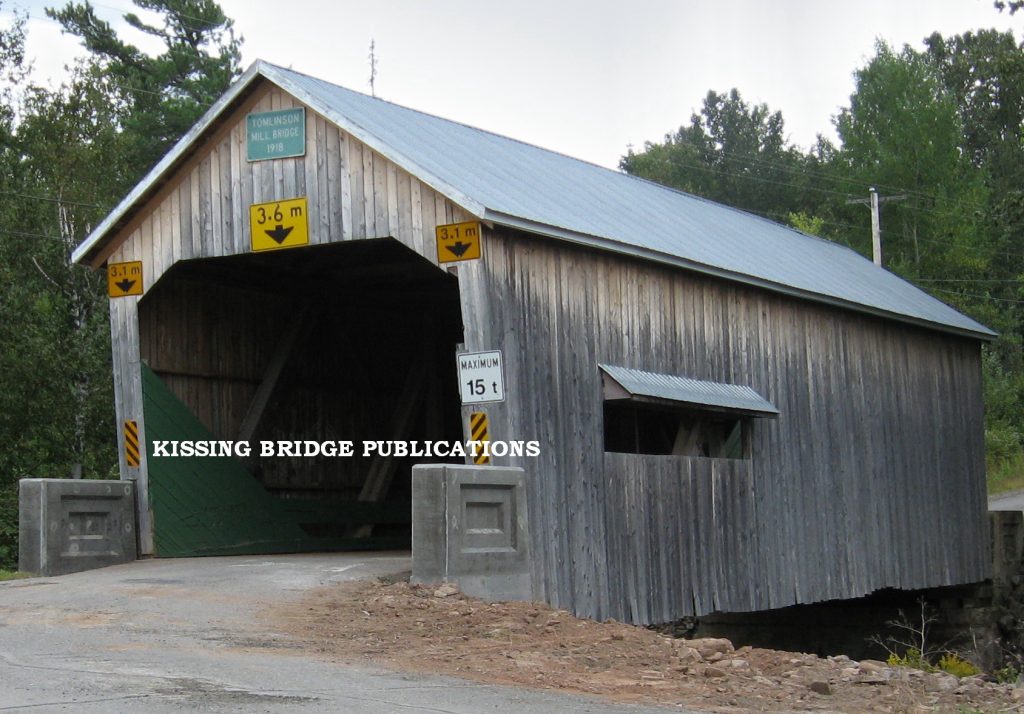

Walkways
Some covered bridges have had walkways added to one side for pedestrian traffic.
The two bridges in St. Martins and the Hartland Bridge are the three New Brunswick covered bridges with walkways.
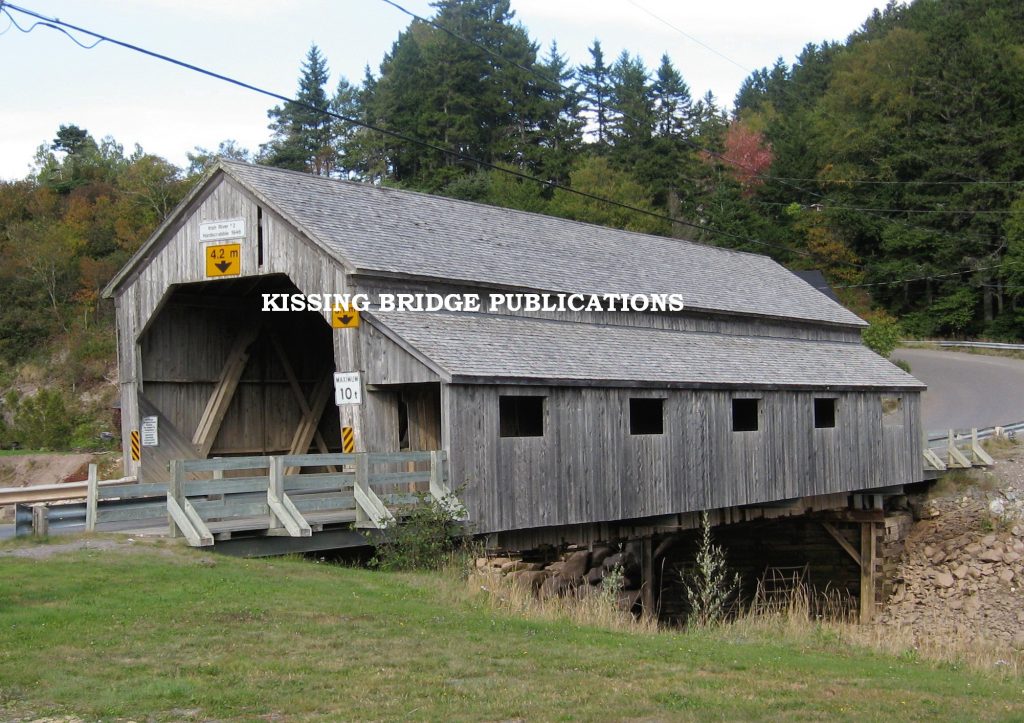
INTERESTING TRIVIA
- Horses were often afraid to cross open rivers but, entering a covered bridge was like going through a barn door so the horses felt safe and crossed willingly.
- Covered bridges earned the name “Kissing Bridges” because, when a couple entered a covered bridge by horse and buggy they would stop to steal a kiss or two.
- When travel was by foot, by horse or by wagon the covered bridge often served as shelter during a sudden storm.
- In winter men were hired to shovel snow onto a covered bridge so sled runners would glide across easier.
- It became good luck to honk one’s car horn when crossing a covered bridge; a tradition still practiced by some to this day.
COVERED BRIDGES IN NEW BRUNSWICK
It has been reported that in the 1800s there were thousands of covered bridges dotting the New Brunswick landscape. We dought that can be substantiated but we do know that in 1950 there were 340 of them still in service in our province. By 2004 however, only sixty-five covered bridges remained. Many of these were lost to flood or arson.
Since 2004 New Brunswick has lost three to arson and two to flooding. Another was dismantled by the provincial government to make room for a steel bridge. We are left with fifty-nine. Of those fifty-nine, ten are no longer in service.
It should be noted that New Brunswick is the sole maritime province with heritage covered bridges. The only other province in Canada with any number is Quebec. Ontario and B.C. each have one.
COVERED BRIDGES IN NEW BRUNSWICK IN 2018
(An * next to bridge name signifies out of service)
Albert County
| Bridge | Built | Location |
| Bramford Colpitts* | 1943 | Private Dr. /Rt. 895/Colpitts Settlement |
| William Mitton* | 1942 | Dismantled in 2022 |
| Peter Jonah* | 1912 | Route 910 at Turtle Creek Reservoir |
| Hartley Steeves | 1923 | Weldon Creek on Rte. 910 at Salem |
| Sawmill Creek* | 1905 | Beside Route 114 at Hopewell Hill |
| Crooked Creek* | 1945 | Crooked Creek rd. 12 k from Rt. 114 |
| Shepody River #3 | 1903 | Germantown – Replaced in 2022 |
| Forty Five River #1 | 1914 | 8.5 kms. off Rte. 114 on 45 Rd. |
| Point Wolfe | 1992 | Wolfe Point in Fundy National Park |
Carleton County
| Bridge | Built | Location |
| Hartland (World’s Longest) 1,282 feet | 1901 | Downtown Hartland |
| Florenceville | 1907 | Downtown Florenceville |
| Ellis | 1909 | On Ellis Rd. near Carlisle |
Charlotte County
| Bridge | Built | Location |
| Maxwell Crossing | 1910 | Maxwell Crossing Rd. / St. Stephen |
| Flume Ridge | 1905 | Off Rte. 3/Mill Rd. near Flume Falls |
| Dumbarton | 1928 | Off Rte. 127 on Tryon Rd./Dumbarton |
| McCann | 1938 | On Rte. 770 at Rollingdam |
| McGuire | 1913 | On Rte. 760 at Elmsville |
| Canal Covered | 1917 | Off Rte. 770 on Canal Rd./St. George |
| Mill Pond* | 1909 | On Little Lepreau Rd. off Rte. 790 |
Kent County
| Bridge | Built | Location |
| Thomas Graham | 1928 | On Route 510 at Graham Creek |
| Cameron’s Mill | 1950 | Cameron’s Mill Cross Rd./ St. Ignace |
Kings County
| Bridge | Built | Location |
| Malone | 1911 | Goshen Rd. near Goshen |
| Plumweseep | 1911 | Plumweseep Rd. off Rte. 114 |
| Salmon* | 1908 | On Rte. 890 near Rte. 1 Exit 195 |
| Tranton | 1927 | Off Rte. 890 on Roachville Rd. |
| Oldsfield | 1910 | Off Rte. 890 on Oldfield Rd. |
| Urney | 1905 | On Urney Rd. near Waterford |
| Moore’s Mill | 1923 | On Drummond Rd. near Waterford |
| McFarlane | 1909 | On Ward’s Creek Rd. off Rte. 111 |
| Centreville | 1911 | Pleasant Ridge Cross Rd. off Rte. 880 |
| Marven | 1903 | Off Rte. 870 on Swamp Rd. |
| Moosehorn Creek* | 1915 | Riverview Drive South at Norton |
| Bloomfield Creek | 1917 | Bloomfield Station Rd. at Bloomfield |
| Smithtown | 1914 | Rte. 860 to Damascus Rd./Smithtown |
| Darling’s Island* | 1914 | Darling’s Island Rd. off Rte. 100 |
| Bayswater | 1920 | On Rte. 845 at Milkish Inlet |
Madawaska County
| Bridge | Built | Location |
| Baker Brook #2* | 1939 | Off Morneault Rd. N-NW of Baker Brook |
| Boniface | 1925 | 15 kms. from Riviere Verte on Davis Rd. |
| Quisibis River #2* | 1951 | Deschenes Rd. 4 kms. N of Rte. 144 |
Northumberland County
| Bridge | Built | Location |
| Nelson Hollow* Oldest in N.B. | 1900 | Lyons Lane off Rte. 8 / Doaktown |
Queens County
| Bridge | Built | Location |
| Burpee | 1913 | Off Rte. 123 on Gaspereau E. Rd., N. of Chipman |
| Starkey* | 1939 | Rte. 2 Exit 365 on Rte. 10 south to Starkey Rd. |
Saint John County
| Bridge | Built | Location |
| Tynemouth Creek | 1927 | Shore Rd. off Rte. 111 at Bains Corner |
| New Vaughan Creek | 2022 | Across Vaughan Creek in St. Martins |
| Hardscrabble | 1946 | Across Vaughan Creek in St. Martins |
Sunbury County
| Bridge | Built | Location |
| Patrick Owen | 1909 | Wilsey Rd. at Rusagonis |
| Mill Settlement | 1912 | Rte. 101 to Mill Sett. Rd to N. Mill Sett. Rd. |
| Hoyt Station | 1936 | Hoyt Station Rd. off Rte. 101 near Hoyt |
Victoria County
| Bridge | Built | Location |
| Tomlinson Mill | 1918 | Tomlinson Mill Rd. near Licford |
Westmorland County
| Bridge | Built | Location |
| Joshua Gallant* | 1935 | Shediac River Rd. off Rte. 11 |
| Poirier | 1942 | Poirier Office Rd. off Rte.115 |
| Budd | 1913 | Victoria Rd. north of Moncton |
| Magnetic Hill | 1916 | At Magnetic Hill in Moncton |
| Hasty | 1929 | Powers Pit Rd. off Rte. 106/Salisbury |
| Boudreau | 1930 | On Gayton Rd. in Memramcook |
| Wheaton | 1916 | High Marsh Rd. near Sackville |
York County
| Bridge | Built | Location |
| Benton | 1927 | On Benton Rd. in Benton |
| Nackawic Siding | 1927 | Nackawic Siding Rd. near Nortondale |
Gloucester County
| Bridge | Built | Location |
| Acadian Village (Replica) | 2000 | At the “Village Historique Acadien” Head of Caraquet Bay |
COVERED BRIDGES IN QUEBEC
There are 85 covered bridges listed here but by 2012 the count was down to 81. The names of those lost were unknown to the author at the time of publication.
Abitibi-Temiscamingue
| Bridge | Built | Location |
| Alphonse Normandin | 1950 | St.-Dominique-du-Rosaire |
| Pont Blanc | 1947 | Chazel |
| Bridge Champagne | 1941 | Val-d’Or |
| Pont l’Arche de Noe | 1937 | Rochebaucourt |
| Pont de l’Ile (Clerval) | 1946 | Clerval |
| Pont de l’Original | 1942 | Rochebaucourt |
| Bridge Calamity | 1927 | La Sarre |
| Bridge Called | 1933 | St.-Bruno-de-Guigues |
| Falls Bridge | 1954 | Rochebaucourt |
| Pont du Petit-Four | 1950 | Clermont |
| Emery-Simard | 1946 | St.-Maurice-de-Dalquier |
| Pont Landry | 1938 | Latulipe-et-Gaboury |
| Bridge Leclerc | 1927 | La Sarre |
| Bridge Levasseur | 1928 | Authier-Nord |
| Pont Molesworth | 1930 | Macamic |
Bas-Saint-Laurent
| Bridge | Built | Location |
| Bridge Falls Neigette | 1933 | St.-Anaclet-de-Lessard |
| Pont Beausejour | ? | Amqui |
| Pont Belanger | 1925 | Metis-sur-Mer |
| L’Anse-Saint-Jean | 1931 | Amqui |
| Pont de Routhierville | 1931 | Routhierville |
| Pont des Draveurs | 1930 | Rimouski |
| Pont du College | 1919 | St.-Onesime d’Ixworth |
| Pont Francois Gagnon | 1942 | St.-Rene-de-Matane |
| Pont Heppell | 1909 | Causapsca |
| Pont Jean-Chasse | 1945 | St.-Rene-de-Matane |
| Pont Pierre-Carrier | 1918 | Saint-Ulric |
| Pont Roman Caron | 1940 | St.-Jean-de-la-Lande |
Capitale-Nationale
| Bridge | Built | Location |
| St.-Placide-de-Charlevoix | 1926 | Baie-Saint-Paul |
Centre-du-Quebec
| Bridge | Built | Location |
| Pont des Cormiers | 1904 | St.-Remi-de-Tingwick |
| Pont des Raymond | 1928 | Becancour |
| Pont Etienne Poirier | 1905 | Saint-Celestin |
| Lambert Bridge | 1948 | Ste.-Sophie-d’Halifax |
| Pont Joseph-Edouard-Perrault | 1929 | Warwick |
Chaudiere-Appalaches
| Bridge | Built | Location |
| Pont Caron | 1933 | Val-Alain |
| Pont Bolduc | 1937 | Ste.-Clotilde-de-Beauce |
| Pont des Defricheurs | 1936 | Ste.-Lucie-de-Beauregard |
| Pont du Sault | 1943 | Saint-Adalbert |
| Pont Perrault | 1928 | Notre-Dame-des-Pins |
| Pont Rouge Ste. Agathe | 1928 | Ste.-Agathe-de-Lotbiniere |
| Pont Saint Andre | 1927 | Saint-Sylvestre |
Cote-Nord
| Bridge | Built | Location |
| Pont Emile-Lapointe | 1945 | Pointe-aux-Outardes |
| Pont Louis-Gravel | 1934 | Sacre-Coeur |
Eastern Townships
| Bridge | Built | Location |
| Pont Cousineau | 1888 | Valcourt |
| Pont de la Frontiere | 1896 | Potton |
| Pont Milby | 1873 | Waterville |
| Pont Eustis | 1908 | Compton |
| Pont Drouin | 1886 | Compton |
| John Cook Bridge | 1868 | Cookshire-Eaton |
| McDermott Bridge | 1886 | Cookshire-Eaton |
| McVetty-McKenzie Bridge | 1893 | Lingwick |
| Narrows Bridge (Quebec) | 1881 | Canton Stanstead |
Gaspesie-Iles-de-la-Madeleine
| Bridge | Built | Location |
| Pont de Saint Edgar | 1928 | New Richmond |
| Pont Galipeault | 1933 | Grande-Vallee |
Lanaudiere
| Bridge | Built | Location |
| Pont Grandchamp | 1918 | Ste.-Genevieve-de-Berthier |
Laurentides
| Bridge | Built | Location |
| Armand Lachaine | 1906 | Chute Saint-Philippe |
| Red Bridge Farm East | 1903 | St.-Aime-du-Lac-des-Iles |
| Red Bridge Farm West | 1903 | St.-Aime-du-Lac-des-Iles |
| Bridge Macaza | 1904 | La Macaza |
| Bridge Prud’homme | 1918 | Brebeuf |
Mauricie
| Bridge | Built | Location |
| Bordeleau Bridge | 1932 | Saint Severin |
| Pont de Saint-Mathieu | 1936 | Saint-Mathieu-du-Parc |
| Pont Ducharme | 1946 | La Bostonnais |
| Pont Thiffault | 1946 | La Bostonnais |
Monteregie
| Bridge | Built | Location |
| Pont Balthazar | 1932 | Brigham |
| Pont Decelles | 1938 | Brigham |
| Pont des Rivieres | 1884 | Notre-Dame-de-Stanbridge |
| Freeport Bridge | 1970 | Cowansville |
| Pont Guthrie | 1888 | Saint-Armand |
| Powerscourt Bridge Oldest in Canada | 1861 | Elgin-Hinchinbrooke |
Nord du Quebec
| Bridge | Built | Location |
| Bridge Traverse | 1940-45 | James Bay |
| Pioneer Bridge | 1943 | James Bay |
| Bridge Memories | 1954 | James Bay |
| Pont Maurice-Duplessis | 1948 | James Bay |
| Pont Taschereau | 1939 | James Bay |
| Bridge Township Laas | 1958 | Lebel-sur-Quevillon |
Outaouais
| Bridge | Built | Location |
| Bridge Cousineau | 1932 | Gracefield |
| Pont de l’Aigle | 1925 | Egan-Sud |
| Meech Creek or Wakefield Bridge | 1924 | Hull formerly Gatineau |
| Felix-Gabriel-Marchand | 1898 | Fort-Coulonge |
| Bridge Kelly | 1923 | Low |
| Bridge Marois | 1933 | Gracefield |
| Pont Savoyard | 1931 | Grand-Remous |
Saguenay-Lac-Saint-Jean
| Bridge | Built | Location |
| Pont du Faubourg | 1929 | L’Anse-Saint-Jean |
| Pont du Lac Ha! Ha! | 1934 | Fernand-et-Bolleau |
| Pont Rouge St.-Jeanne d-Arc | 1936 | Saint-Jeanne d’Arc |
Covered Bridge in Other Provinces
Though many replicas, pedestrian bridges and wannabes grace the Canadian landscape only two other Canadian provinces outside of New Brunswick and Quebec have true heritage covered bridges.
Ontario – West Montrose Covered Bridge is the only covered bridge found in Ontario. Also known as ‘The Kissing Bridge’ this 208 feet bridge was built in 1881. This red bridge spans Grand River on Covered Bridge Drive in West Montrose. Its’ width of 17 feet allows for two way traffic. It was declared a heritage structure in 2007.
British Columbia – Ashnola #1 Bridge known locally as the Red Bridge (the paint colour) it is the last remaining covered bridge in British Columbia. It was originally constructed by the Great Northern Railway as a railroad bridge in 1907. Unlike the covered road bridges we are familiar with, the Ashnola is without a conventional roof. Instead, the cover is built over the superstructure on each side of the bridge leaving the roof area open to the air. It’s three spans bridge 942 feet across the Similkameen River near Keremeos. The railway tracks were removed in 1954 and after sitting idle for six years it was repurposed as a highway bridge in 1961.